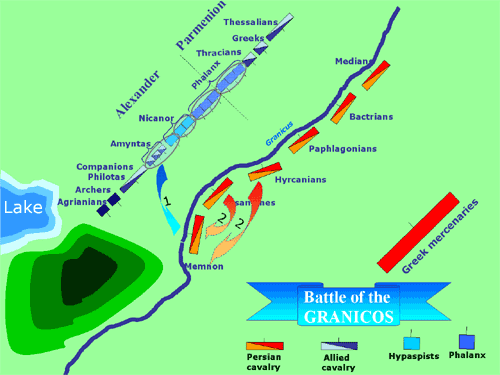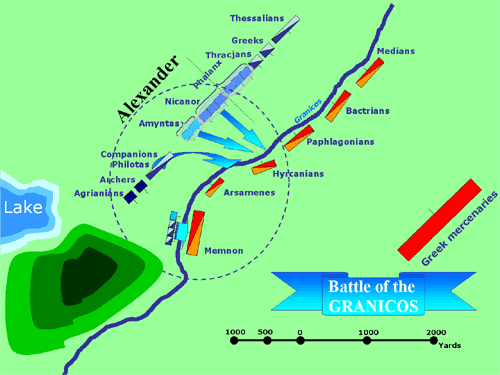- Articles Index
- Monthly Features
- General History Articles
- Ancient Near East
- Classical Europe and Mediterranean
- East Asia
- Steppes & Central Asia
- South and SE Asia
- Medieval Europe
- Medieval Iran & Islamic Middle East
- African History (-1750)
- Pre-Columbian Americas
- Early Modern Era
- 19'th Century (1789-1914)
- 20'th Century
- 21'st Century
- Total Quiz Archive
- Access Account
The Battle of Granikos (Granicus)
By Maciek
| Fought in Asia Minor, Granicus was the first major victory of Alexander over the Persians.
I
This shows the basic position of both armies. The first move made by Alexander was to send Nicanor's cavalry, supported by one battalion of hypaspists, to attack the extreme left of the Persian line (1). This was to drive part of the force from the middle left of the Persian line This tactic can be called as the concentration of the forces (producing the advantage) on the main attack direction, which we see on this map. When the middle left of Persian army became weaker, Alexander concentrated all his right wing to attack one point of the enemy's line. The attack was so furious that the Macedonians pushed the Persians from the shore just past the uphill water (where his infantry, the phalanx could not fight). The Phalanx then came up to flat ground behind the cavalry to develop a line to supported the attack. Alexander, who was in his armour with plumes on his helmet, was very visible, and thus all Persian commanders tried to attack him. During this fight Alexander broke a few sarrisas - and always, there would be somebody who gave him another. But this one moment was particulary dangerous. It was when Alexander was attacked from behind and only the quick reaction of Cleitus saved him. Cleitus the black was one of oldest commanders in Alexander's army and later, he would get in a fight with Alexander which Cleitus the Black (as he was called) would be killed.
II
Now, all the effort was concentrated in pushing the enemy completely from the shore. The companions successfully broke through, and subsequently, alowing the phalanx could to form the line in the center just after crossing the river to start the attack. After this, the hetairoi cavalry, supported by infantry, took the advantage. The Persian line was now broken and nothing could save them - except escape.
III After breaking the Persians formation, the Macedonians surrounded the Greek mercenaries. According to the Corinthian League's rules, no Greek may fight on the side of Greek enemies. Thus, all the mercienaries were regarded as the traitors and after a short fight almost all of them were killed. The small number of survivors (about 2 thousands) where sent to Macedonian mines to work as a slaves. After two years Alexander set them free when many Athenian and other city-states citizens came to him and asked for mercy to the mercenaries. All Battle Maps are (c) by and are the works of Maciek.
|





